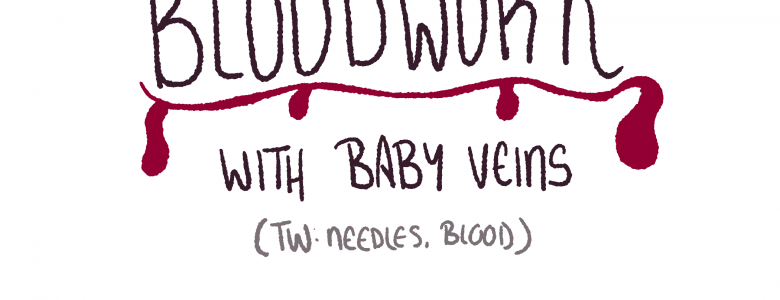January 16, 2021
What Happens to Your Blood After it’s Tested?

By: burgundy bug
“Bloodwork with Baby Veins” by editor burgundy bug
Source: BugsBoops
After you’ve been pricked, prodded, and poked, pretty, little, crimson vials of your blood are shipped off to a lab, never to be seen again.
But what happens after it’s been tested? Is your blood fed to vampires in government warehouses to keep them from prowling the streets and feeding on people? Is it stored away in towering, futuristic refrigerators along with thousands of other samples for further experimentation?
Trigger warning: The following article contains descriptions of blood and needles, which may be upsetting for some individuals. If you’re particularly squeamish, keep reading at your own risk.
Well, first thing’s first — it probably isn’t being used to satiate the appetite of bloodthirsty vampires.
“Twilight is actually pretty funny”
Source: Twilight is actually pretty funny | Synthetic Rose
If you’ve ever brushed your eyes across a doctor’s office or hospital room as you twiddled your thumbs, awaiting the doctor’s arrival, you’ve likely locked eyes with a big, ol’, neon-colored “BIOHAZARD WASTE” bin.
A scientist wearing blue gloves carrying a red bag with a bioharzard sign
Source: Adobe Stock
Once your blood has fulfilled its testing purposes, it’s disposed of as biohazardous waste.
But before it’s tossed out, the United States Occupational Safety and Health Administration says the pathologists and technicians must ensure it’s in a spill-proof, puncture-resistant container.
This is to ensure any contaminants within the blood can’t seep out and infect the environment around it.
According to MedSafe Waste, there are multiple disposal methods for biological waste. These include:
- Autoclave: This is a machine that uses steam sterilization to destroy potential contaminants in medical waste with high pressure
- Chemical agents: A chemical agent is added to the waste to kill its potential contaminants
- Incineration: The medical waste may also be disposed of by burning it at very high combustion temperatures
Regulations for disposing of biohazardous waste may vary by state or landfill, as well.
Here in Pennsylvania, our state’s code says blood must be disposed of at a permitted medical waste processing facility.
The facility must not dispose of chemotherapeutic waste and pathological waste. It must also have an autoclave and use an agent to turn the liquid blood into “solid or gels so that no free liquid remains.”
Once it becomes a solid, it’s allowed to be disposed of at a department-authorized landfill.
But What About Biobanking?

“The last several decades have seen tremendous improvements in the collection and storage of human samples, allowing the worldwide scientific community to obtain very important results in the field of medical research,” says a Journal of Translational Medicine review. “Today we can collect, store, and preserve tissues, cells, DNA, proteins, and other subcellular components on a long-term basis.”
Biobanks contain samples of various human biological materials (blood, tissue samples, tumors, etc…) for genetic analysis and “associated information,” the review explains.
These regulated structures exist to:
- Collect and store biological materials with their relevant data
- Provide materials for current or future research projects
- Anonymize the data and materials to ensure the donor’s privacy
- Include structures and procedures — such as consent — to “protect the donors’ rights and stakeholder interests”
Despite the potential biobanks have for furthering scientific advancements, there’s a lot of bioethical concerns surrounding them. Their databases contain sensitive information, which the review says are “considered dangerous to human rights.”
These concerns lead to the World Medical Association’s Declaration of Taipei, which aims to establish an equilibrium between the donors’ rights and the importance of their samples to medical research.
Informed consent is also a big topic of discussion and debate in the biobanking industry. It’s important to allow the individual to decide whether or not they would like their samples to be used in studies.
But biobanks need to be flexible, so they use a “broad consent” model. This means the donor has agreed their samples may be used in future studies, but they won’t be contacted later down the road in regards to the results of the research.
But I Didn’t Consent to Biobanking!
Or did you? The paperwork could’ve been thrown in along with other forms that you filled out before your bloodwork and you just weren’t paying attention.
In Conclusion
Blood tests offer a vital gateway to reaching a better understanding of your health. Just a few milliliters of your blood can tell your doctor a lot about what’s going on inside of your body.
But after the tests are over and done with, where does the blood go? Well, it must be disposed of according to the regulations implemented by the state and local landfill.
In Pennsylvania, biohazardous waste must be sterilized and the landfill is required to have a permit to handle medical waste, such as blood.
Furthermore, some of your blood may find it’s way to a biobank for future research purposes.
But never fear, dear. There are enough rules and regulations in the scientific community to ensure your blood probably won’t be used for something extreme, like cloning… Hopefully.
Interested in having content featured in an upcoming blog post or issue of The Burgundy Zine? Head on over to the submissions page!
For all other inquiries, please fulfill a contact form.



